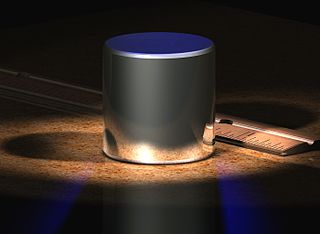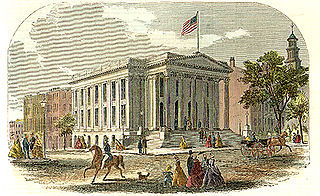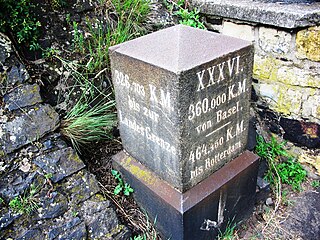
The kilogram or kilogramme is the base unit of mass in the International System of Units (SI). Until 20 May 2019, it remains defined by a platinum alloy cylinder, the International Prototype Kilogram, manufactured in 1889, and carefully stored in Saint-Cloud, a suburb of Paris. After 20 May, it will be defined in terms of fundamental physical constants.

The litre or liter is an SI accepted metric system unit of volume equal to 1 cubic decimetre (dm3), 1,000 cubic centimetres (cm3) or 1/1,000 cubic metre. A cubic decimetre occupies a volume of 10 cm×10 cm×10 cm and is thus equal to one-thousandth of a cubic metre.
The metre or meter is the base unit of length in the International System of Units (SI). The SI unit symbol is m. The metre is defined as the length of the path travelled by light in vacuum in 1/299 792 458 of a second.

Metrication or metrification is conversion to the metric system of units of measurement. Worldwide, there has been a long process of independent conversions of countries from various local and traditional systems, beginning in France during the 1790s and spreading widely over the following two centuries, but the metric system has not been fully adopted in all countries and sectors.

The Metre Convention, also known as the Treaty of the Metre, is an international treaty that was signed in Paris on 20 May 1875 by representatives of 17 nations. The treaty created the International Bureau of Weights and Measures (BIPM), an intergovernmental organization under the authority of the General Conference on Weights and Measures (CGPM) and the supervision of the International Committee for Weights and Measures (CIPM), that coordinates international metrology and the development of the metric system.

The pound or pound-mass is a unit of mass used in the imperial, United States customary and other systems of measurement. Various definitions have been used; the most common today is the international avoirdupois pound, which is legally defined as exactly 0.45359237 kilograms, and which is divided into 16 avoirdupois ounces. The international standard symbol for the avoirdupois pound is lb; an alternative symbol is lbm, #, and ℔ or ″̶.
A metric prefix is a unit prefix that precedes a basic unit of measure to indicate a multiple or fraction of the unit. While all metric prefixes in common use today are decadic, historically there have been a number of binary metric prefixes as well. Each prefix has a unique symbol that is prepended to the unit symbol. The prefix kilo-, for example, may be added to gram to indicate multiplication by one thousand: one kilogram is equal to one thousand grams. The prefix milli-, likewise, may be added to metre to indicate division by one thousand; one millimetre is equal to one thousandth of a metre.

The tonne, commonly referred to as the metric ton in the United States and Canada, is a non-SI metric unit of mass equal to 1,000 kilograms or one megagram. It is equivalent to approximately 2,204.6 pounds, 1.102 short tons (US) or 0.984 long tons (UK). Although not part of the SI, the tonne is accepted for use with SI units and prefixes by the International Committee for Weights and Measures.
United States customary units are a system of measurements commonly used in the United States. The United States customary system developed from English units which were in use in the British Empire before the U.S. became an independent country. However, the United Kingdom's system of measures was overhauled in 1824 to create the imperial system, changing the definitions of some units. Therefore, while many U.S. units are essentially similar to their Imperial counterparts, there are significant differences between the systems.

The metric system is an internationally recognised decimalised system of measurement. It is in widespread use, and where it is adopted, it is the only or most common system of weights and measures. It is now known as the International System of Units (SI). It is used to measure everyday things such as the mass of a sack of flour, the height of a person, the speed of a car, and the volume of fuel in its tank. It is also used in science, industry and trade.

The gram is a metric system unit of mass.

The stone or stone weight is an English and imperial unit of weight now equal to 14 pounds (6.35029318 kg).
The Mendenhall Order marked a decision to change the fundamental standards of length and mass of the United States from the customary standards based on those of England to metric standards. It was issued on April 5, 1893, by Thomas Corwin Mendenhall, superintendent of the U.S. Coast and Geodetic Survey, with the approval of the United States Secretary of the Treasury, John Griffin Carlisle. The order was issued as the Survey's Bulletin No. 26 - Fundamental Standards of Length and Mass.

The grave was the original name of the kilogram, in an early version of the metric system between 1793 and 1795.

The metric system was developed during the French Revolution to replace the various measures previously used in France. The metre is the unit of length in the metric system and was originally based on the dimensions of the earth, as far as it could be measured at the time. The litre, is the unit of volume and was defined as one thousandth of a cubic metre. The metric unit of mass is the kilogram and it was defined as the mass of one litre of water. The metric system was, in the words of French philosopher Marquis de Condorcet, "for all people for all time".
The international yard and pound are two units of measurement that were the subject of an agreement among representatives of six nations signed on 1 July 1959, namely the United States, United Kingdom, Canada, Australia, New Zealand and the Union of South Africa. The agreement defined the yard as exactly 0.9144 meters and the pound as exactly 0.45359237 kilograms.

The following outline is provided as an overview of and topical guide to the metric system – various loosely related systems of measurement that trace their origin to the decimal system of measurement introduced in France during the French Revolution.

The imperial system of measurement and the US customary system of measurement are both derived from an earlier English system of measurement which in turn can be traced back to Ancient Roman units of measurement, and Carolingian and Saxon units of measure.














